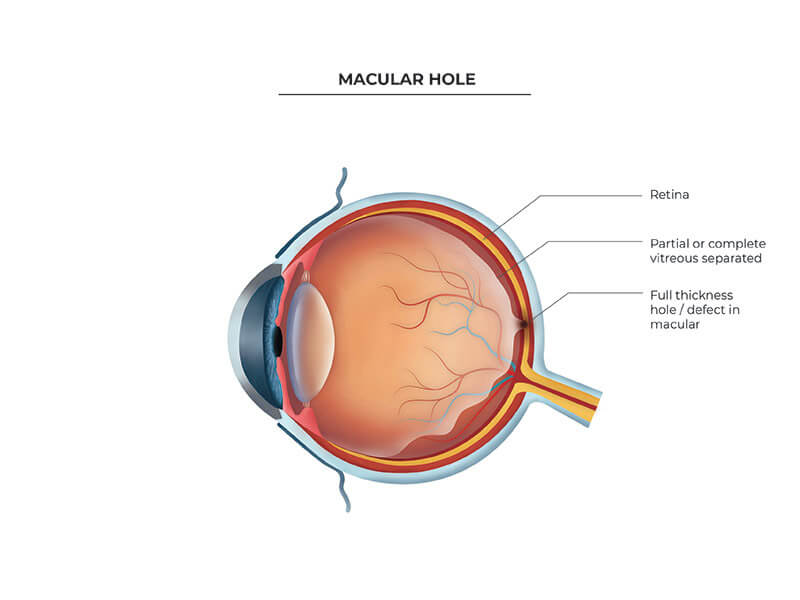Macular Hole Surgery
What is a macular hole?
The macula is the centre of the retina where the highest visual acuity is obtained. A macular hole is a full thickness defect in this important location of the retina. It is equivalent to a hole in the centre of the film in a camera. This hole is as a result of traction (pulling) of the vitreous on the retina. The vitreous is a…
What can be done for a macular hole?
A small or partial-thickness macular hole may close spontaneously without any intervention, whereas a large or full-thickness macular hole usually requires surgery. A surgical procedure is performed which involves removing the vitreous gel and internal…
What can I expect after surgery?
Gas placed within the eye will be gradually reabsorbed by the eye during a 2-8 week period following surgery. As the bubble is reabsorbed, the vitreous cavity refills with a fluid that is naturally produced in the eye.
What is a macular hole?
The macula is the centre of the retina where the highest visual acuity is obtained. A macular hole is a full thickness defect in this important location of the retina. It is equivalent to a hole in the centre of the film in a camera. This hole is as a result of traction (pulling) of the vitreous on the retina.
The vitreous is a gel-like substance which fills the central cavity of the eye. As you age, the vitreous undergoes changes and “shrinks”. It eventually pulls itself loose from the retina, in a process called a “posterior vitreous separation”. When it does this, it can pull on the centre of the macula and create a full-thickness defect.
There is no actual loss of tissue in the hole. Visual acuity decreases markedly depending on the size of the hole. This is due to disruption of the normal physiologic arrangement of the photoreceptors (light sensing cells) in the centre of the macula, and due to collection of fluid under the retina in this area.
 Image of a macular hole. The vitreous separates from the retina and is more adherent at the macula.
Image of a macular hole. The vitreous separates from the retina and is more adherent at the macula.
What can be done for a macular hole?
A small or partial-thickness macular hole may close spontaneously without any intervention, whereas a large or full-thickness macular hole usually requires macular hole surgery. A surgical procedure is performed which involves removing the vitreous gel and internal limiting membrane (the innermost layer of the retina) to relieve the traction on the macula. This, together with the placement of a gas bubble, creates an optimal environment for the cells to migrate across and for the hole close. The hole cannot be manually plugged or closed; the surgery creates the optimal environment for the hole to close itself.
The vitreous gel is replaced with a slowly dissolving inert gas at the end of your surgery. The surface tension of the gas bubble acts to aid in closure of the macular hole. There are three types of gas, lasting between 2 and 8 weeks. The characteristics of the macular hole will determine which type of gas tamponade is required. In order to maximize the effect of the bubble, you may be requested to maintain face down (prone) positioning or positioning on your side for a period of time after the surgery. This ensures that the gas bubble with stay in contact against the macular hole.
What can I expect after macular hole surgery?
Gas placed within the eye will be gradually reabsorbed by the eye during a 2-8 week period following surgery. As the bubble is reabsorbed, the vitreous cavity refills with a fluid that is naturally produced in the eye. Vision will be markedly reduced after the surgery as you cannot see well through the bubble. As the bubble reabsorbs you will gradually see more and more. You should not expect a significant improvement in your vision until at least 6 weeks after the surgery. The maximum improvement will be noticed between 6 weeks and 9 months after the macular hole surgery, and vision may continue to improve as the retina remodels itself.
You may not fly in an airplane or travel to high elevations (i.e. mountains) until the bubble is completely gone. Some types of general anaesthetic agents must be avoided (nitrous oxide or laughing gas) while there is a bubble in your eye.
There is usually very little pain following the operation. It is common to experience mild irritation for a few days after the surgery. You will be given an eye shield which should be worn while sleeping for the first week. You will be given a prescription for some light painkillers to be used for 3 days, and eye drops to be used for 4 weeks.
If you think you might have a macular hole, contact an ophthalmologist for an examination.